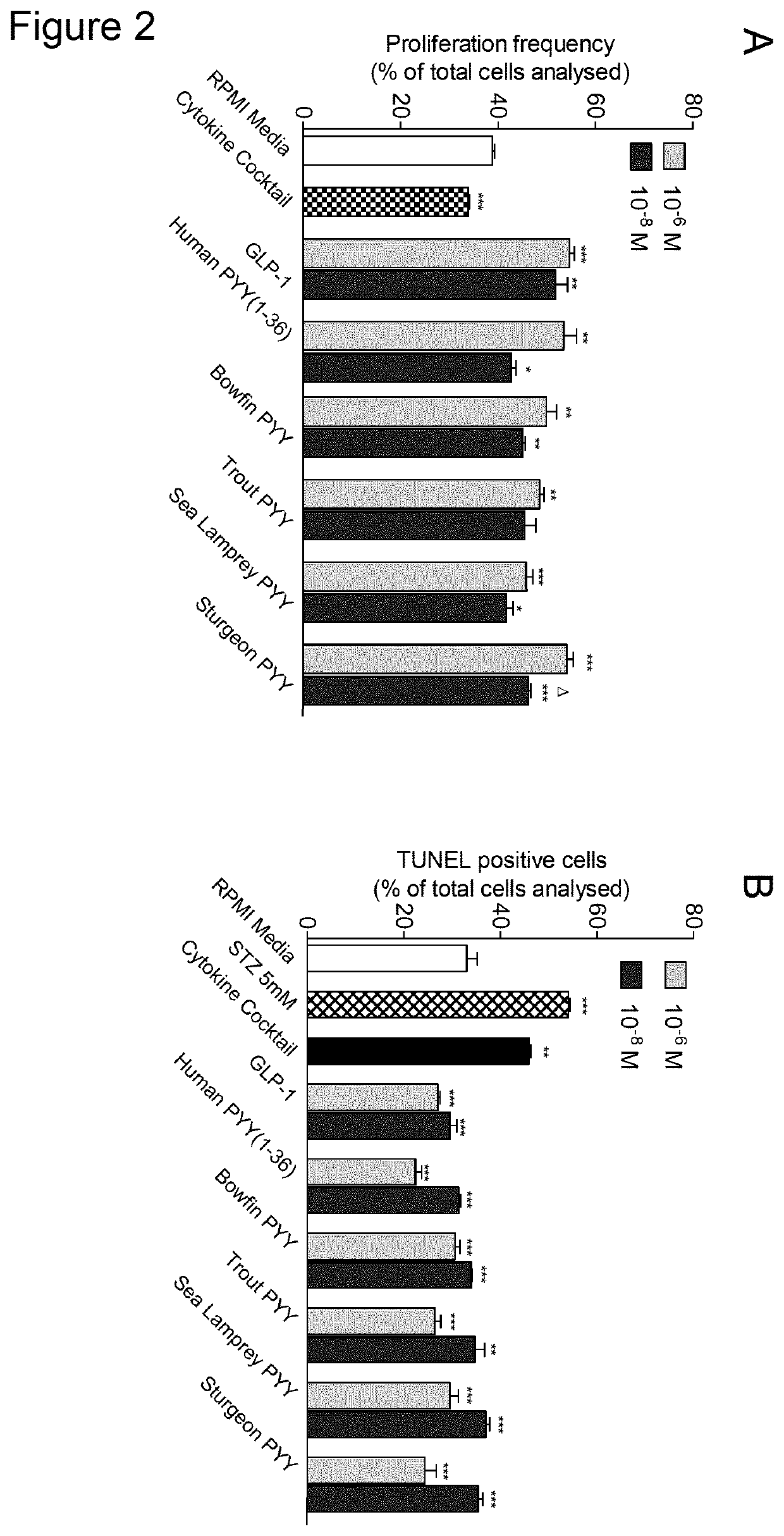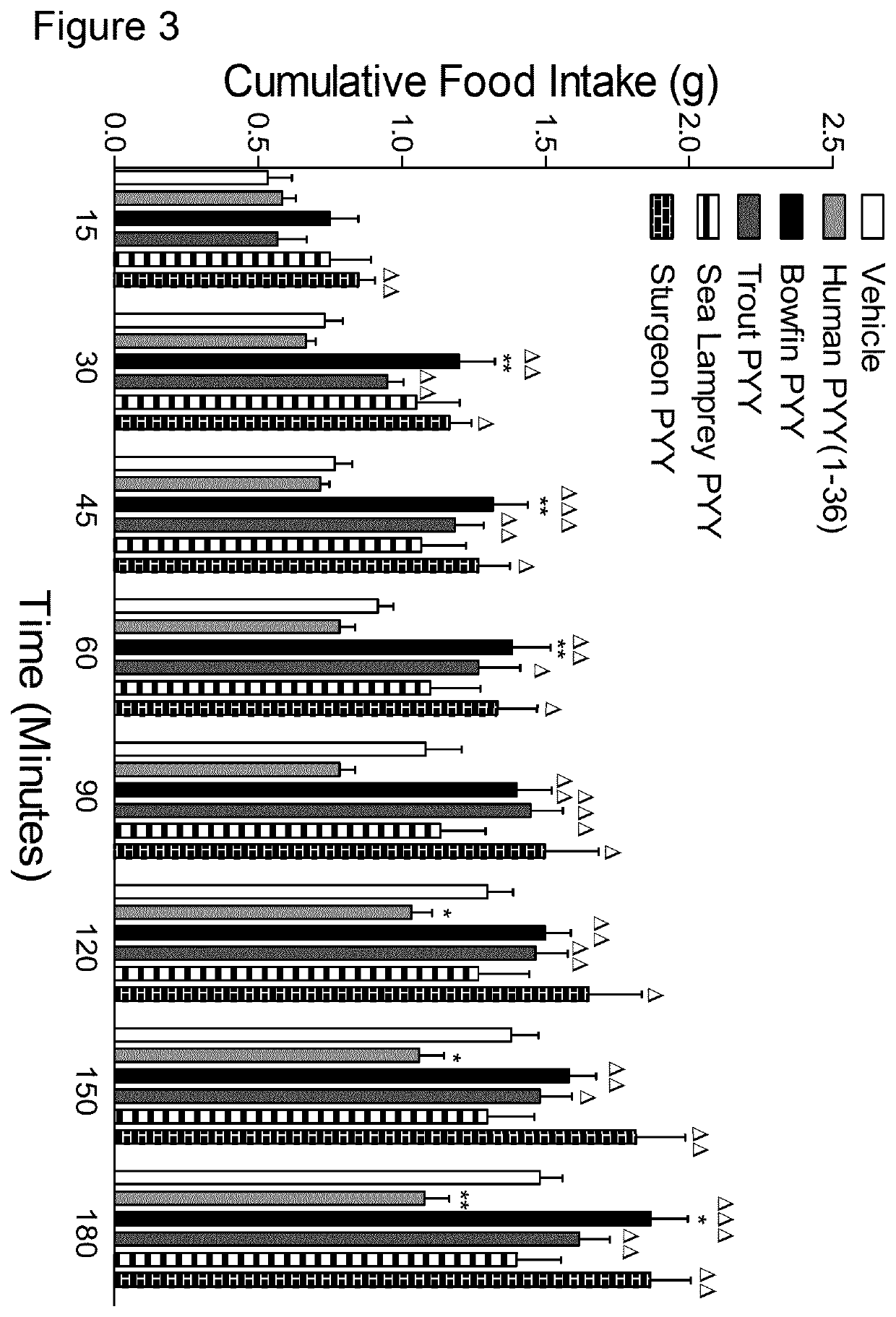Piscine-derived pyy peptides for use in treating a metabolic disorder
a metabolic disorder and peptide technology, applied in the field of peptides for use in the treatment of diabetes, can solve the problems of not being able to achieve the impressive enhancement of metabolic control, and achieve the effects of reducing beta-cell apoptosis, increasing beta-cell proliferation in the body, and increasing beta-cell proliferation
- Summary
- Abstract
- Description
- Claims
- Application Information
AI Technical Summary
Benefits of technology
Problems solved by technology
Method used
Image
Examples
example 1
Identification of Stable, Y1 Receptor Specific, PYY Peptides; and DPP-4 and Murine Plasma Degradation Analyses
[0197]The inventors were initially able to narrow down potential lead candidates based on computation structure / function analyses to yield stable, Y1 receptor specific, PYY peptides. Thus, trout, bowfin, sturgeon and sea lamprey PYY forms were chosen for further analysis.
[0198]Following incubation of peptides with purified DPP-4 or murine plasma and HPLC analysis, collected fractions for each time-point (0, 2 and 8 h) were subsequently mixed with α-cyano-4-hydroxycinnamic acid and applied to a Voyager-DE BioSpectrometry Workstation and mass-to-charge (m / z) ratio verses peak intensity recorded. The results are shown in Table 1.
TABLE 1Amino acid sequence of PYY peptides, as well as DPP-4 and murine plasmadegradation analysesSEQDPP-4PlasmaIDhalf-half-Amino acid sequenceNOPeptidelifelifeYPIKPEAPGEDASPEELNRYYASLRHYLNLVTRQRY-8HumanNH2PYY(1-36)YPPKPENPGEDAPPEELARYYSALRHYINLITRQRY-5...
example 3
Effects of Human PYY and Related Piscine-Derived PYY Species on Human Beta-Cell Proliferation and Apoptosis
[0200]The effects of human PYY(1-36) and four piscine-derived PYY variants (each at 10−8 and 10−6 M) on proliferation and protection against apoptosis in human 1.1B4 beta-cells were investigated; as described in the beta-cell proliferation and apoptosis studies methodology above. Proliferation was measured by Ki-67 staining and apoptosis by TUNEL assay following incubation of peptides in the presence of a cytokine cocktail (TNF-α (200 U / mL), IFN-γ (20 U / mL) and IL 1B (100 U / mL)). The results are shown in FIG. 2. FIG. 2A shows the effects of human PYY(1-36) and four piscine-derived PYY variants (each at 10−8 and 10−6 M) on proliferation in human 1.1B4 beta-cells. FIG. 2B shows the effects of human PYY(1-36) and four piscine-derived PYY variants (each at 10−8 and 10−6 M) on protection against apoptosis in human 1.1B4 beta-cells. Values are mean±SEM (n=4). *pΔp<0.05 compared to re...
example 4
Effects of Human PYY and Related Piscine-Derived PYY Species on Feeding
[0201]The effects of human PYY(1-36) and four piscine-derived PYY variants on food intake in overnight fasted mice were investigated; as described in the food intake methodology above. Cumulative food intake was assessed following intraperitoneal administration of vehicle (0.9% NaCl) alone or in combination with test peptide (each at 25 nmol / kg bw). The results are shown in FIG. 3. Values are mean±SEM (n=6). *pΔpΔΔpΔΔΔp<0.001 compared to human PYY(1-36).
PUM
| Property | Measurement | Unit |
|---|---|---|
| half life | aaaaa | aaaaa |
| half life | aaaaa | aaaaa |
| time | aaaaa | aaaaa |
Abstract
Description
Claims
Application Information
 Login to View More
Login to View More - R&D
- Intellectual Property
- Life Sciences
- Materials
- Tech Scout
- Unparalleled Data Quality
- Higher Quality Content
- 60% Fewer Hallucinations
Browse by: Latest US Patents, China's latest patents, Technical Efficacy Thesaurus, Application Domain, Technology Topic, Popular Technical Reports.
© 2025 PatSnap. All rights reserved.Legal|Privacy policy|Modern Slavery Act Transparency Statement|Sitemap|About US| Contact US: help@patsnap.com



